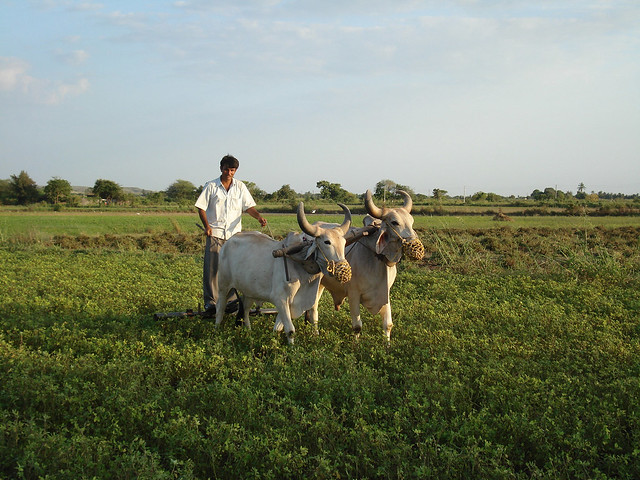
photo credit: IFPRI 2007
A farmer in Ghungti Village of Junagdh District in the state of Gujarat, India. Smallholder farmers are dependent on livestocks for harvesting and land preparation due to small land sizes.
UPDATE: There is a small discussion of this writing over on The Oil Drum today. It was pointed out that this report's figure of 30% as the global energy use for the food system might be highly overstated. I did some further checking, and to see this explained, please see my comment under this post. Also, since this post is long, please don't miss my conclusion at the end of this report describing my outlook for the future of agriculture during energy descent.
~~~~~~~
The food sector uses around 30 percent of total global primary energy consumption. Petroleum products are used to transport, produce, cook, and store food, and the success of feeding the world's growing populations can largely be attributed to fossil fuel inputs à la Norman Borlaug's green revolution."It is this increased reliance of global food systems on fossil fuels that is now becoming cause for concern."
The above statement is the reason behind a new 78-page [pdf] report from the Food and Agriculture Organization (FAO) of the United Nations titled, " 'Energy-Smart' Food for People and Climate". The report is ambitious, as it tries to confront climate change and energy use, as well as other problems facing global agriculture while including the goal to advance the world's poorest farmers. In my review of this report, I wish to focus primarily upon the fossil fuel dependence issue in agriculture.
The following chart helps to demonstrate the changes in energy intensity resulting from the green revolution. As you see, energy intensity has gone down in 63 years of U.S. corn growing due to yield gains albeit at the expense of high fossil fuel inputs:

chart: FAO
The FAO warns that "unlike the 1960’s and 1970’s green revolution, our ability to reach these targets (to feed the world's growing populations) may be limited in the future by a lack of inexpensive fossil fuels." It is important to note that low input systems can have relatively high energy intensities if they produce a low yield. The reverse is also true that high energy input systems can have lower energy intensities if they result in high yields, as in the corn example above.
For such an important story, that of global food security in the face of diminishing and more expensive energy resources, I've been surprised how little attention has been focused upon it to date, as it is one of the subjects which concerns me the most in agriculture. The other major report which comes to mind was the USDA's August publication titled "Impacts of Higher Energy Prices on Agriculture and Rural Economies," a 56-page [pdf] report that was featured on this blog here a few months ago.
Smaller important groups such as Wes Jackson's Land Institute in Kansas, the well-known blog The Oil Drum, and the Post Carbon Institute with the Energy Bulletin site, however, have been highly concerned about this problem facing us in agriculture. Among proposed solutions by these groups are perennial grains, organic methods, rotational grazing of livestock, foodshed models, agroforestry, eat local movements, slow money, farmers markets and local co-ops, urban agriculture and victory gardens.
The FAO report takes an overall optimistic and nonalarmist outlook on this subject and plans to approach it by way of the following points:
• using more ecologically-friendly farming methods that significantly improve yields for subsistence farmersAlso, from the FAO's report, they link the historical relationship between food prices and energy prices as demonstrated in these two graphs:
• improving access to freshwater and using water more efficiently
• promoting the efficient management of natural resources and energy
• substituting fossil fuels with low-carbon resources and clean energy technologies
• reducing losses and waste along the food chain.

graphs: FAO
The next few paragraphs excerpted from the report name specific exajoules (EJ) per year used by our current Ag system.
[1.0 Quad = One quadrillion Btu (1015 Btu) = 1.055 exajoules (EJ), or approximately 172 million barrels of oil equivalent (boe).]
How much energy does the globe's agriculture system use?
"Once conventional oil and gas flows reach a peak as is predicted, the food sector’s continued reliance on these non-renewable resources for production, processing and transportation activities will lead to greater business risks, especially from unpredictable price spikes. Excluding human and animal power, on-farm direct energy demand is around 6 EJ/yr. Slightly over half of the on farm energy is consumed in OECD countries. This energy is used mainly for pumping water, housing livestock, cultivating and harvesting crops, heating protected crops, drying and storage.
In addition, indirect energy demands for operating boats, tractors, and other farm machinery as well as for fertilizer manufacturing is around 9 EJ/yr. The synthesis of nitrogenous fertilizers alone consumes approximately 5 percent of the annual natural gas demand (around 5 EJ/yr). For fisheries, global primary production directly consumes around 2 EJ/yr of total final energy. Fisheries direct energy consumption is mainly associated with boat propulsion, pond aeration and water pumping. Around 0.4 EJ/yr of indirect energy is embedded in aquaculture feedstuffs.
These figures illustrate how heavily dependent agriculture is on the energy sector.
... The end-use energy demand of the global food sector is around 32 percent of current total global final energy demand. The food sectors in high-GDP countries consume over half of the global energy demand for the sector."
In addition, indirect energy demands for operating boats, tractors, and other farm machinery as well as for fertilizer manufacturing is around 9 EJ/yr. The synthesis of nitrogenous fertilizers alone consumes approximately 5 percent of the annual natural gas demand (around 5 EJ/yr). For fisheries, global primary production directly consumes around 2 EJ/yr of total final energy. Fisheries direct energy consumption is mainly associated with boat propulsion, pond aeration and water pumping. Around 0.4 EJ/yr of indirect energy is embedded in aquaculture feedstuffs.
These figures illustrate how heavily dependent agriculture is on the energy sector.
... The end-use energy demand of the global food sector is around 32 percent of current total global final energy demand. The food sectors in high-GDP countries consume over half of the global energy demand for the sector."
Beyond the scope of this report is the fact that a few major regions of the world do the grain commodity exporting upon which the remainder of the world depends and that many of the major oil exporters are food insecure.
As always is the case in agriculture, much of what will determine handling the descent in energy resources problem will come down to government policies, price supports, and possible taxpayer funded subsidies for fuel and other energy intensive input costs of production, especially in an age where more financial risk will be required to plant crops using industrial methods. In the end, it is policy and not often logic which dictates winners and losers in Ag production.
I found it ironic that while the subject of the report was concern about the world agricultural system's dependence upon fossil fuels, included was the recommendation that the poorest farmers advance from being fossil fuel independent to using two-wheeled tractors to increase their production. This seems reasonable when you take into account that much of industrial crop production today is unnecessary overproduction and if that fuel use were more evenly distributed it would add considerably towards global food security. Yet, as is often the case whenever this despairing subject is tackled, it seemed the writers were grasping for solutions, some of them highly complex, and some having a great amount of embedded energy within them, such as the utopian New Holland "Energy Efficient Farm" they used as an example, which integrates a fuel cell tractor into a mix of renewables on the farm.
The report states that there were 27 million tractors operating in the world in 2005 and that one-third of them were in the low-GDP nations. The tractors of the world consumed 5 EJ of diesel fuel for land development, transport and field operations. The amount of fuel used by two-wheeled tractors by small farmers is unknown. Today, 80 percent of farm cultivation in Africa is still done by hand and with animal-power.
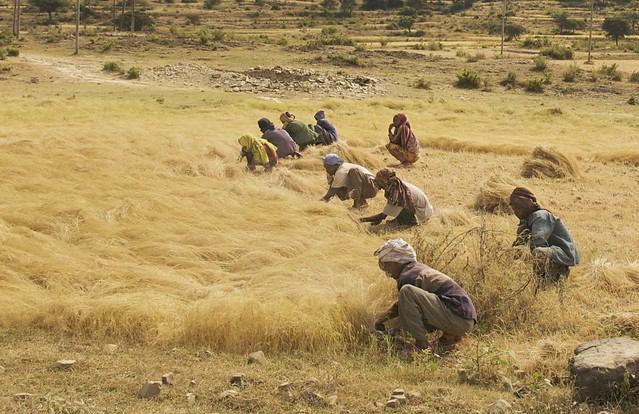
photo: flickr cc via A. Davey
The Teff Harvest 2007, Northern Ethiopia*
Men and women harvest the Ethiopian staple grain teff in a roadside field between Axum and Adwa in Northern Ethiopia.
Also, interesting was the fact that the report used Bangladesh as a positive model, since it has been successful in recent years at increasing agricultural production, in part by using small and very efficient two-wheeled tractors powered by simple diesel engines made in China. These small, mobile, demountable diesel engines can be used interchangeably for tractors, trucks, electrical generation, to power boats, to operate processing equipment, and to power water pumps. They are easy to repair and less expensive "compared to the more fuel-efficient machinery manufactured in India." The success of this engine's use in Bangladesh has set off a new growth market for similar small engines as low-cost farm machinery in poor rural communities.
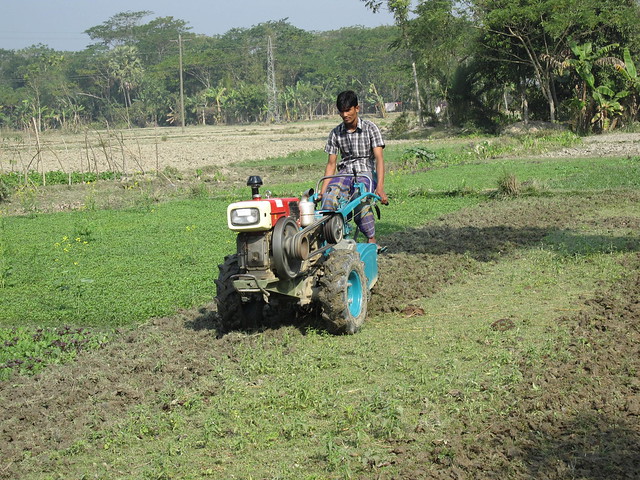
Photo by Save the Children.
As part of the PepsiCo Foundation's 'Enhancing Life and Livelihoods' program in Bangladesh, farmers received new farming equipment, including tills, to mechanize production and increase crop yield.
Through a number of programs in recent years, the developed nations have been teaching and bringing low tech, low energy, and renewable energy methods to the developing nations to advance their quality of life in everyday tasks of cooking, food growing, communication, lighting, and water pumping or catchment. These energy efficient farming and cooking methods may prove to be invaluable techniques for all of us in an energy-scarce future. Perhaps Bangladesh's simple demountable diesel engine is one such example.
The report advocated embracing as much alternative energy as possible into farms including biofuels, biogas waste digesters, wind and solar. Efficient cook stoves and better insulated cool storage were also mentioned.
Energy use for irrigation, fertilizers, livestock, protected cropping, forestry and fishing were each addressed in the report, as were the drying of cereals, cooling, storage, transport and distribution of food. Next, are a few points which were included in the discussion of these subjects:
- Around two-thirds of global water supplies used for irrigation are drawn from underground aquifers out of ever deeper wells.
- Not all of today's fertilizer is being used efficiently.
- In 2000, energy embedded in the production of inorganic fertilizer was around 7 EJ globally.
- Nitrogen fertilizer production accounts for about half of the fossil fuels used in primary production.
- Crops grown in greenhouse can have energy intensity demands around 10 to 20 times that of the same crops grown in open fields.
- Capture fishing is one of the most energy-intensive methods of food production.
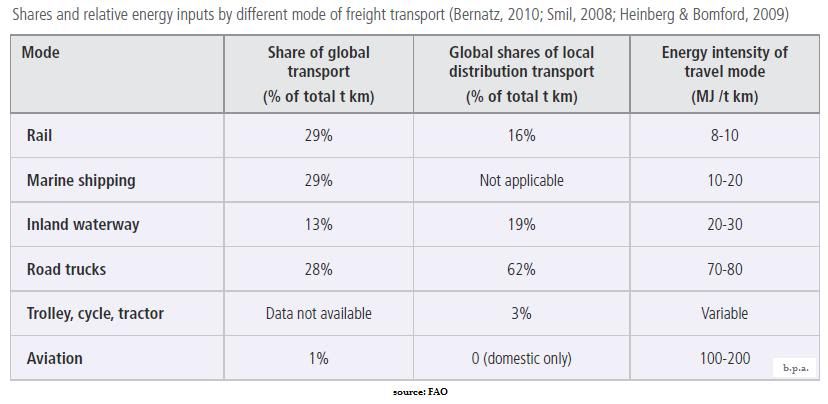
As a proposed solution, this FAO publication discusses Integrated food-energy systems (IFES). IFES would combine food and energy systems within large-scale regional farming areas utilizing both monoculture and ‘mixed farming’ systems, which integrate livestock, pasture and crop production on the same property. Techniques such as multiple cropping, agro-forestry, livestock, and fish production would be used. Generating renewable bioenergy from crop residues and animal waste are also suggested. These methods would rely more upon human and animal inputs, and less on external inputs.
Next, is a chart which lists ideas to lower energy use in the food system:
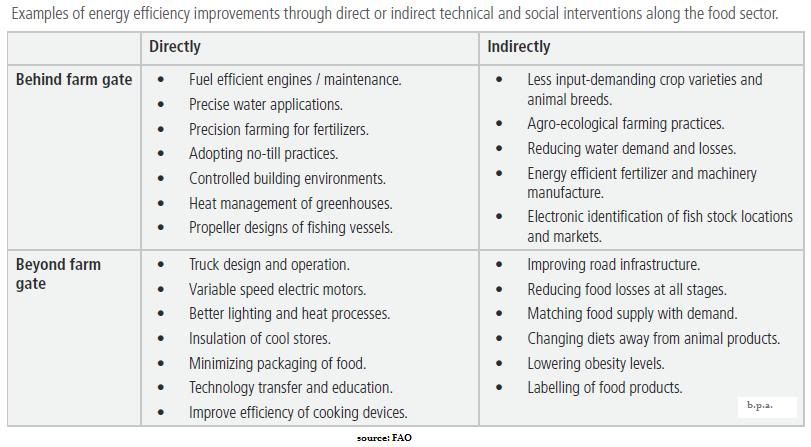
Not ignored by the report were long term sustainability factors such as biodiversity, soil quality, improved livelihoods and health. What was not addressed in depth was the ongoing debate of organic versus industrial methods, and I would have liked to have seen livestock intensification energy inputs evaluated.
Conclusion
I expect that as fossil fuels become more expensive and/or less available the excessive slack will be worked out of the agricultural system. Such slack includes today's overproduction of crops such as corn, soy, and wheat as well as unaffordable deep pump irrigation. Increasing efficiency to increase yield while decreasing energy inputs will be the name of the game.
A large amount of slack in our developed nations food system is the highly processed and overly packaged foods that we eat. A return to eating real food out of bulk bin style grocery stores and open air markets will make us healthier, freeing up some of the current embedded energy and costs in our food, but this will be disastrous for much of the corporate food industry.
In the shorter term, increased price volatility and more frequent climate change induced crop failures will make farming which uses industrial farming methods riskier as input costs go ever higher. The weakest producers will be forced out of production, as in the past in farming. This will lead industrial farmers to choose alternative farming methods offering lower input costs. The current momentum is still for larger farms and larger equipment, however.

photo: flickr cc via Erwin Schoonderwaldt
John Deere combine harvest in Sweden 2010
Production may become that of the extremes of methods. I agree with this and other reports which state that integrating multiple farming methods will be the answer for some time into the foreseeable future. Expect manufacturers to increase the fuel efficiency of tractors and combines. It is possible that the ultimate model for low energy intensity in grain production will be the thirty mile long farm using the largest of equipment with GPS and other high tech systems. This method will be cost prohibitive to the "family" farmer, of course and may eventually become a government owned production system. The other extreme, then, will be the small acreage farmer using very small equipment, small tractors, or animal power. These smaller scale systems will surround the towns and urban areas.
Organic methods, growing the crops appropriate for respective regions, returning to rotational grazing, and using more human (and animal) labor will be included in the lower energy input solutions. This will eventually lead to fewer cereal exports from the grain exporting nations of today.
Fruits and vegetables will be grown more regionally and local canning and meat processing facilities will come back. Part of the driver for this will be the desire for local and individual food security, even though some of these crops may be produced more efficiently elsewhere.
Early slack to come out of the Ag system will be the failure of remote farms which are dependent upon long distance transportation and rural electricity. These regions may become large scale grazing areas. Think big cattle drives or buffalo commons. Surviving, functional farms will follow the grid and railroad service lines, or be self-sufficient in renewable electrical production.
Corn ethanol production will gradually fail as people will not tolerate the high food prices associated with it as well as the fact that it makes us (the U.S.) less competitive in the global agricultural commodity export markets. Biodiesel would be especially useful in farming regions where production is possible.
Once diesel or required farm fuels become intermittent in availability, then serious measures will be taken to stop relying on high energy input farming methods, even though energy will be subsidized or allotted by the government for farming. Farmland prices will plummet and today's large agribusinesses will decline. Younger people will return to farming since land will again be affordable and for food security reasons. People and communities will grow their own food to save money as food will become quite expensive. With this new dynamic, brand new rural communities may sprout up here and there with common resident goals of living energy efficient lifestyles while being food secure.
It is also possible that some bread baskets of the world will be involved in a "food for oil" exchange. World trade of agricultural commodities may revert to methods other than fiat currency payments.
Many global agricultural reports that try to address the major problems facing us these days seem to suggest that we unify global goals to problem-solve, as if we could have some global world order established. Is this possible or is it just wishful thinking?
——Kay McDonald
Note that this conclusion is my own, and was not taken from the FAO report.
__________________________________
*
According to Wikipedia:
Teff or taf (Eragrostis tef, Amharic ṭēff, Tigrinya ṭaff) is an annual grass, a species of lovegrass native to the northern Ethiopian Highlands of northeastern Africa.
It has an attractive nutrition profile, being high in dietary fiber and iron and providing protein and calcium.
It has a sour taste. It is similar to millet and quinoa in cooking, but the seed is much smaller.
Teff is an important food grain in Ethiopia and Eritrea, where it is used to make injera . . . (It is now raised in the USA, in Idaho in particular.)
Because of its small seeds (less than 1 mm diameter), one [person] can hold enough to sow a large area in one hand. This property makes teff particularly suited to a seminomadic lifestyle.
The word "tef" is connected by folk etymology to the EthioSemitic root "ṭff", which means "lost" (because of the small size of the grain).
__________________________________
Note that the lead author of the paper " 'Energy-Smart' Food for People and Climate"was Ralph E. H. Sims (Massey University, New Zealand). The project was led and managed by Olivier Dubois (Climate, Energy and Tenure Division of FAO’s Natural Resources Management and Environment Department) who also provided major contributions to the text. Colleagues from this division also contributed to the paper. Alessandro Flammini collated and analysed the data and together with Erika Felix and Anne Bogdanski contributed to the text. Very useful review comments were received from FAO colleagues in other departments: Francis Chopin, Theodor Friedrich, Peter Holmgren, Josef Kienzle, Michela Morese, David Muir, Jonathan Reeves and Peter Steele. Martina Otto (United Nations Environment Programme, UNEP), Prof Ravindranath (Indian Institute of Science), Uwe Schneider (University of Hamburg) and Pete Smith (Aberdeen University) also provide valuable input.